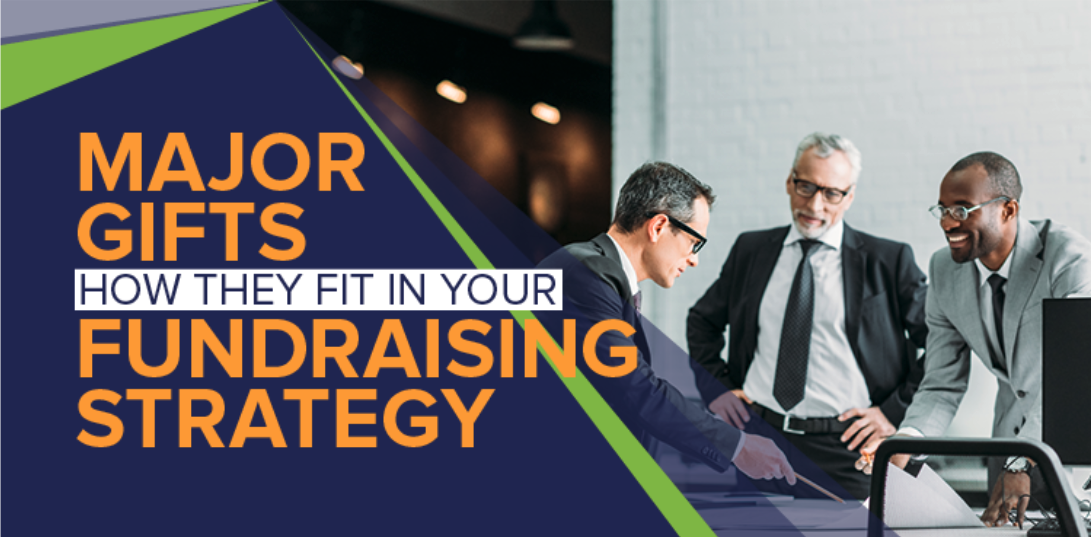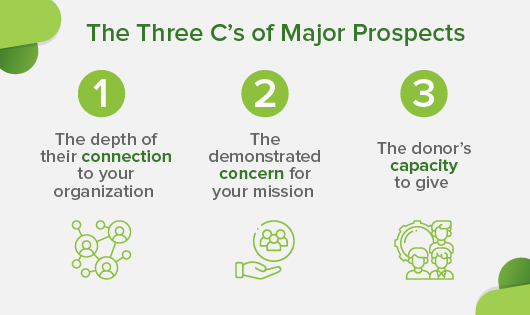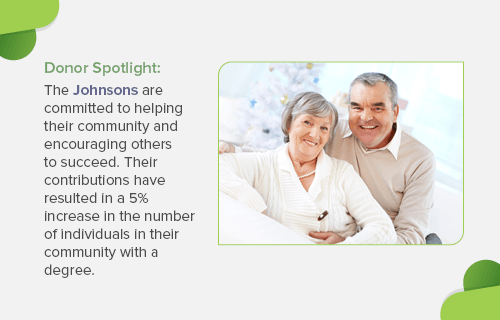
Major gifts are an important part of any basic fundraising strategy. They’re essential because they’re the largest contributions you receive from individual donors.
Many organizations refer to the 80-20 rule (or the Pareto principle) to discuss the importance of major donations. This principle dictates that 80% of a nonprofit’s funding is contributed by only the top 20% of their donors. Not every nonprofit fits perfectly into this model, but there’s no doubt that major gifts are an essential aspect of any nonprofit’s funding. 360MatchPro’s fundraising statistics show that over 5 years, major gifts of over $1,000 grew to 85% of the revenue generated at an average nonprofit.
In this guide, we’ll discuss how to locate and solicit major gifts from your supporters as well as how to continuously source new major donations to continue growing your fundraising program as a whole. We’ll cover the following:
- Finding major donors
- Soliciting major gifts
- Thanking major donors
- Sourcing new major gifts
The definition of a major gift is different for each nonprofit, depending on the average gift size that you receive and what supporters have contributed in the past. Define what a major donation is for your nonprofit before diving into the identification and solicitation steps of your major gift program.
1. Finding major donors
If you’re just developing your first major gift program, these gifts will fit seamlessly into your existing strategy. This is because your initial major donors are likely already in your fundraising system—you just may not have found them yet.
Major donors rarely come out of the blue and give at the major donation level for their first contribution to your cause. Instead, they usually start at a lower-tier contribution level until they have a strong relationship with your organization. Then, you can ask for larger gifts, or “upgrades.”
Therefore, the first place to look for current major donors and prospects is in your donor database. You’ll be looking for those who demonstrate the three C’s: connection to your organization, concern for your mission, and capacity to give at the major level.

You can find this information by analyzing each donor’s:
- History with your nonprofit. Long-term engagement shows that the donor has a connection to your organization and cares about helping you succeed.
- Motivation to give. Ask donors why they care about your cause, then engage them further with campaigns and initiatives that align with their motivations; this will increase their concern for your cause.
- Capacity to give. Leverage prospect research to determine a donor’s wealth capacity to assess if they can give at the level that you’ve defined as a major contribution to your cause.
Locate the major prospects who are already in your donor database and qualify them by asking if they want a deeper relationship with your cause. From there, create a specific donor segment for your major prospects in your communications strategy. Then, you can start building strong and personal relationships with these prospects. Invite them to one-on-one meetings, ask for their input and opinions, and invite them to exclusive opportunities.
2. Soliciting major gifts
After you’ve developed relationships with your prospects, you can move into the solicitation phase of your major gift program. Asking someone for $20 is a lot different than asking someone for $5,000. Therefore, make sure you develop a concrete strategy for how you’ll enter into this conversation.
Consider the setting of the conversation.
Ask your major supporters if they prefer in-person or virtual meetings. Different people will have different comfort levels when it comes to meeting in person. Plus, virtual meetings are often easier to schedule for donors with busier schedules. However, in-person meetings tend to be more intimate and personal than virtual ones.
If you do meet in person, choose a quiet space like a living room or home office. This provides privacy and reduces the number of potential distractions during the meeting itself.
Use appropriate solicitation language.
First, tell your supporter how much you appreciate their past support for your organization. They’ve probably been involved with your mission for a while, so be sure to express your appreciation for their previous contributions before asking for additional support.
To get the conversation going, consider asking the donor about their personal philanthropic goals, and why they have supported your organization in the past. Give them an update on your organization’s service offerings and upcoming goals. Remember the old adage “If you want money, ask for advice. If you want advice, ask for money.” Their thoughts and comments may prove useful in making the ask, and what you ask for.
When it comes time to make the ask, frame it as a consideration, saying something like, “Would you consider contributing a gift in the $5,000 range for the Save a Dolphin program?” This is a polite, yet direct way to approach the question. Be sure to also have a specific program or initiative that the contribution would help fund to provide additional context for what the money would support.
In the case that a donor can’t give the full initial amount that you ask for, be sure you have the next level donation tier in mind that you can ask for. A smaller donation amount than expected is better than walking out of the meeting empty-handed.
3. Thanking your major donors
After a major donor gives to your cause, you must say thank you and show ample appreciation for their gift. This stewardship shows them that you care and helps continue building on the relationships you’ve already established with these supporters.
Often, showing appreciation for major donors looks a little different than it would for your other supporters. Because the gifts are so substantial, you need to take the appreciation strategies to the next level. We recommend incorporating appreciation strategies such as:
- Calling your major donors. Calling your donors allows you to show your appreciation in a more personal way. Over the phone, you can provide context about how their gift was used to support your mission and personally express gratitude for their gift. This also shows them that you’re taking the time to show appreciation rather than lumping them into a mass appreciation email stream.
- Hand-writing letters to your donors. Similar to calling your supporters, writing a letter by hand also shows that you’re willing to take time out of your day to say thank you for their support. Your donors will appreciate the personal touch of seeing your executive director’s or major gift officer’s signature on the letter.
- Building a donor recognition wall. Donor recognition walls are often located somewhere at your organization’s headquarters and feature the names of the supporters who have given in large quantities to your organization. These walls not only show your appreciation by recognizing those who have given in the past, but they also encourage other donors to give in greater quantities to be featured alongside these major donors.
- nviting major donors to exclusive events. Invite your donors to join the VIP lounge at your next event. Or, invite them to an intimate dinner simply to say thank you to those who give in the greatest quantities to your organization. This not only provides an opportunity to say thank you, but it also allows these supporters to network with one another.
- Featuring these supporters in your annual report. Your annual report sums up the various programs and initiatives from the year, providing additional context and financial information about your nonprofit. It’s also the perfect opportunity to shout out some of your major donors and recognize the part they played in making your initiatives possible. Bloomerang’s annual report guide provides the following example of a donor spotlight, showing what this might look like:

Don’t just pick one of these strategies to run with. Leverage multiple strategies to remind supporters of your appreciation on several different occasions. For example, you might call them a week after the donation is made, send a letter a week after that, and be sure their name is added to your donor recognition wall within the month. As with any donation, you should send an acknowledgment email as soon as you receive the donation to assure the donor that their gift was received and to say thank you as quickly as possible.
4. Sourcing new major gifts
Your major gift program should constantly be evolving. There are always opportunities to steward your existing supporters and continuously build relationships with them. There are also always opportunities to source new major donors from your growing donor pool. We recommend starting with your mid-tier donors.
In your organization’s pyramid of donors, your mid-level donors are just behind your major donors. But they’re too often overlooked by major giving programs. This results in many nonprofits not paying their mid-tier supporters the attention and recognition they deserve. This is a huge missed opportunity because these supporters could be your next major donors!
Focus on building relationships with these supporters so that you can eventually reach out and qualify them for your major gift program if their connection with your organization, dedication to your cause, and capacity to give all increase. Even if they don’t become major donors, your mid-tier donors can still become a substantial source of revenue if you focus on developing relationships with these important supporters.
____________________________________
Major gifts generally make up a substantial portion of a nonprofit’s total revenue. Your major gift strategy should focus on engaging your major donors and developing strong relationships with them. Just as engagement is the backbone of your general retention strategy, it will also help keep your major donors coming back year after year.
____________________________________
Guest Post by Jay Love, Co-Founder and current Chief Relationship Officer at Bloomerang
Jay Love has served this sector for 33 years and is considered the most well-known senior statesman whose advice is sought constantly.
Prior to Bloomerang, he was the CEO and Co-Founder of eTapestry for 11 years, which at the time was the leading SaaS technology company serving the charity sector. Jay and his team grew the company to more than 10,000 nonprofit clients, charting a decade of record growth.
He is a graduate of Butler University with a B.S. in Business Administration. Over the years, he has given more than 2,500 speeches around the world for the charity sector and is often the voice of new technology for fundraisers.